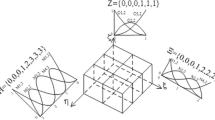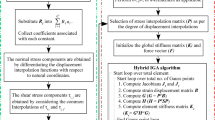Abstract
This work undertakes to combine the interests of IsoGeometric Analysis (IGA) and standard Finite Element Methods (FEM) for the global/local simulation of structures. The idea is to adopt a hybrid global-IGA/local-FEM modeling, thereby benefiting from: (i) the superior geometric description and per-Degree-Of-Freedom accuracy of IGA for capturing global, regular responses, and (ii) the ability of FEM to compute local, strongly non-linear or even singular behaviors. For the sake of minimizing the implementation effort, we develop a coupling scheme that is fully non-invasive in the sense that the initial global spline model to be enriched is never modified and the construction of the coupling operators can be performed using conventional FE packages. The key ingredient is to express the FEM-to-IGA bridge, based on Bézier extraction, to transform the initial global spline interface into a FE one on which the local FE mesh can be constructed. This allows to resort to classic FE trace operators to implement the coupling. It results in a strategy that offers the opportunity to simply couple an isogeometric code with any robust FE code suitable for the modelling of complex local behaviors. The method also easily extends in case the users only have at their disposal FE codes. This is the situation that is considered for the numerical illustrations. More precisely, we only make use of the FE industrial software Code_Aster to perform efficiently and accurately the hybrid global-IGA/local-FEM simulation of structures subjected locally to cracks, contact, friction and delamination.
























Similar content being viewed by others
References
Hughes TJR, Cottrell JA, Bazilevs Y (2005) Isogeometric analysis: CAD, finite elements, NURBS, exact geometry and mesh refinement. Comput Methods Appl Mech Eng 194:4135–4195
Cottrell JA, Hughes TJR, Bazilevs Y (2009) Isogeometric analysis: toward Integration of CAD and FEA, 1st edn. Wiley, London
Cohen E, Lyche T, Riesenfeld R (1980) Discrete B-spline and subdivision techniques in computer aided geometric design and computer graphics. Comput Graphics Image Process 14:87–111
Piegl L, Tiller W (1997) The NURBS book, 2Nd. Springer, New york
Tirvaudey M, Bouclier R, Passieux JC, Chamoin L (2019) Non-invasive implementation of nonlinear Isogeometric Analysis in an industrial FE software. Eng Comput 37:237–261
Xu G, Mourrain B, Duvigneau R, Galligo A (2013) Analysis-suitable volume parameterization of multi-block computational domain in isogeometric applications. Comput Aided Des 45:395–404
Massarwi F, Antolin P, Elber G (2019) Volumetric untrimming: precise decomposition of trimmed trivariates into tensor products. Comput Aided Geom Des 71:1–15
Ruess M, Schillinger D, Özcan AI, Rank E (2014) Weak coupling for isogeometric analysis of non-matching and trimmed multi-patch geometries. Comput Methods Appl Mech Eng 169:46–71
Wei X, Marussig B, Antolin P, Buffa A (2021) Immersed boundary-conformal isogeometric method for linear elliptic problems. Comput Mech 68:1385–1405
Wang J, Zhou G, Hillman M, Madra A, Bazilevs Y, Du J, Su K (2021) Consistent immersed volumetric Nitsche methods for composite analysis. Comput Methods Appl Mech Eng 385:114042
De Luycker E, Benson DJ, Belytschko T, Bazilevs Y, Hsu MC (2011) X-FEM in isogeometric analysis for linear fracture mechanics. Int J Numer Meth Eng 87:541–565
Yuan H, Yu T, Bui TQ (2021) Multi-patch local mesh refinement XIGA based on LR NURBS and Nitsche’s method for crack growth in complex cracked plates. Eng Fract Mech 250:107780
Fathi F, de Borst R (2021) Geometrically nonlinear extended isogeometric analysis for cohesive fracture with applications to delamination in composites. Finite Elem Anal Des 191:103527
Verhoosel CV, Scott MA, De Borst R, Hughes TJR (2011) An isogeometric approach to cohesive zone modeling. Int J Numer Meth Eng 87:336–360
Dimitri R, De Lorenzis L, Wriggers P, Zavarise G (2014) NURBS-and T-spline-based isogeometric cohesive zone modeling of interface debonding. Comput Mech 54:369–388
Borden MJ, Hughes TJR, Landis CM, Verhoosel CV (2014) A higher-order phase-field model for brittle fracture: Formulation and analysis within the isogeometric analysis framework. Comput Methods Appl Mech Eng 273:100–118
Proserpio D, Ambati M, De Lorenzis L, Kiendl J (2020) A framework for efficient isogeometric computations of phase-field brittle fracture in multipatch shell structures. Comput Methods Appl Mech Eng 372:113363
Paul K, Zimmermann C, Mandadapu KK, Hughes TJR, Landis CM, Sauer RA (2020) An adaptive space-time phase field formulation for dynamic fracture of brittle shells based on LR NURBS. Comput Mech 65:1039–1062
Gendre L, Allix O, Gosselet P (2009) Non-intrusive and exact global/local techniques for structural problems with local plasticity. Comput Mech 44:233–245
Passieux JC, Réthoré J, Gravouil A, Baietto MC (2013) Local/global non-intrusive crack propagation simulation using a multigrid X-FEM solver. Comput Mech 56:1381–1393
Li H, O’Hara P, Duarte CA (2021) Non-intrusive coupling of a 3-D Generalized Finite Element Method and Abaqus for the multiscale analysis of localized defects and structural features. Finite Elem Anal Des 193:103554
Fuenzalida-Henriquez I, Oumaziz P, Castillo-Ibarra E, Hinojosa J (2022) Global-Local non intrusive analysis with robin parameters: application to plastic hardening behavior and crack propagation in 2D and 3D structures. Comput Mech 69:965–978
Meray F, Chaise T, Gravouil A, Depouhon P, Descharrieres B, Nélias D (2022) A novel SAM/X-FEM coupling approach for the simulation of 3D fatigue crack growth under rolling contact loading. Finite Elem Anal Des 206:103752
Gerasimov T, Noii N, Allix O, De Lorenzis L (2018) A non-intrusive global/local approach applied to phase-field modeling of brittle fracture. Adv Model Simul Eng Sci 5(1):1–30
Noii N, Aldakheel F, Wick T, Wriggers P (2020) An adaptive global-local approach for phase-field modeling of anisotropic brittle fracture. Comput Methods Appl Mech Eng 361:112744
Aldakheel F, Noii N, Wick T, Wriggers P (2021) A global-local approach for hydraulic phase-field fracture in poroelastic media. Comput Math Appl 91:99–121
Duval M, Passieux JC, Salaün M, Guinard S (2016) Non-intrusive coupling: recent advances and scalable nonlinear domain decomposition. Arch Comput Methods Eng 23:17–38
Gosselet P, Blanchard M, Allix O, Guguin G (2018) Non-invasive global-local coupling as a Schwarz domain decomposition method: acceleration and generalization. Adv Model Simul Eng Sci 5:1–23
Oumaziz P, Gosselet P, Boucard PA, Guinard S (2019) A parallel non-invasive mixed domain decomposition-Implementation and applications to mechanical assemblies. Finite Elem Anal Des 156:24–33
Guinard S, Bouclier R, Toniolli M, Passieux JC (2018) Multiscale analysis of complex aeronautical structures using robust non-intrusive coupling. Adv Model Simul Eng Sci 5:1–27
Wangermez M, Allix O, Guidault PA, Ciobanu O, Rey C (2020) Interface coupling method for the global-local analysis of heterogeneous models: A second-order homogenization-based strategy. Comput Methods Appl Mech Eng 365:113032
Bouclier R, Passieux JC, Salaün M (2016) Local enrichment of NURBS patches using a non-intrusive coupling strategy: Geometric details, local refinement, inclusion, fracture. Comput Methods Appl Mech Eng 300:1–26
Bouclier R, Passieux JC (2020) A Nitsche-based non-intrusive coupling strategy for global/local isogeometric structural analysis. Comput Methods Appl Mech Eng 340:253–277
Bouclier R, Hirschler T (2022) IGA:non-conforming couplingand shape optimization of complex multipatchstructures. Wiley, londen. https://doi.org/10.1002/9781119988557
Colantonio G, Chapelier M, Bouclier R, Passieux JC, Marenic E (2020) Noninvasive multilevel geometric regularization of mesh-based three-dimensional shape measurement. Int J Numer Meth Eng 121:1877–1897
Borden M, Scott MA, Evans JA, Hughes TJR (2011) Isogeometric finite element data structures based on Bézier extraction of NURBS. Int J Numer Meth Eng 87:15–47
Scott M, Borden M, Verhoosel C, Sederberg T, Hughes TJR (2011) Isogeometric finite element data structures based on bézier extraction of T-splines. Int J Numer Meth Eng 88:126–156
Schillinger D, Ruthala PK, Nguyen LH (2016) Lagrange extraction and projection for NURBS basis functions: A direct link between isogeometric and standard nodal finite element formulations. Int J Numer Meth Eng 108:515–534
Cottrell JA, Hughes TJR, Reali A (2007) Studies of refinement and continuity in isogeometric structural analysis. Comput Methods Appl Mech Eng 196:4160–4183
Kamensky D, Bazilevs Y (2019) tIGAr: Automating isogeometric analysis with FEniCS. Comput Methods Appl Mech Eng 344:477–498
Quarteroni A, Manzoni A, Negri F (2015) Reduced basis methods for partial differential equations: an introduction, vol 92. Springer, Berlin
Hesthaven JS, Rozza G, Stamm B (2016) Certified reduced basis methods for parametrized partial differential equations, vol 590. Springer, Berlin
Benner P, Grivet-Talocia S, Quarteroni A, Rozza G, Schilders W, Silveira LM (2022) Model order reduction: snapshot-based methods and algorithms, De Gruyter
Hennig P, Müller S, Kästner M (2016) Bézier extraction and adaptive refinement of truncated hierarchical NURBS. Comput Methods Appl Mech Eng 305:316–339
D’Angella D, Reali A (2020) Efficient extraction of hierarchical B-Splines for local refinement and coarsening of Isogeometric Analysis. Comput Methods Appl Mech Eng 367:113131
Evans E, Scott M, Li X, Thomas D (2015) Hierarchical T-splines: analysis-suitability, Bézier extraction, and application as an adaptive basis for isogeometric analysis. Comput Methods Appl Mech Eng 284:1–20
Chen L, de Borst R (2018) Adaptive refinement of hierarchical T-splines. Comput Methods Appl Mech Eng 337:220–245
Brivadis E, Buffa A, Wohlmuth B, Wunderlich L (2015) Isogeometric mortar methods. Comput Methods Appl Mech Eng 284:292–319
Bouclier R, Passieux JC, Salaün M (2017) Development of a new, more regular, mortar method for the coupling of NURBS subdomains within a NURBS patch: Application to a non-intrusive local enrichment of NURBS patches. Comput Methods Appl Mech Eng 316:123–150
Miao D, Zou Z, Scott MA, Borden M, Thomas DC (2020) Isogeometric Bézier dual mortaring: The enriched Bézier dual basis with application to second-and fourth-order problems. Comput Methods Appl Mech Eng 363:112900
de Prenter F, Verhoosel CV, van Zwieten GJ, van Brummelen VH (2017) Condition number analysis and preconditioning of the finite cell method. Comput Methods Appl Mech Eng 316:297–327
Allix O, Gosselet P (2020) Non intrusive global/local coupling techniques in solid mechanics: An introduction to different coupling strategies and acceleration techniques. Modeling in engineering using innovative numerical methods for solids and fluids. Springer, Cham, pp 203–220
Chevreuil M, Nouy A, Safatly E (2013) A multiscale method with patch for the solution of stochastic partial differential equations with localized uncertainties. Comput Methods Appl Mech Eng 255:255–274
Geuzaine C, Remacle JF (2009) GMSH: a three-dimensional finite element mesh generator with built-in pre- and post-processing facilities. Int J Numer Meth Eng 79:1309–1331
Ribes A, Caremoli C (2007) Salome platform component model for numerical simulation. In: 31st Annual International Computer Software and Applications Conference (COMPSAC 2007) 2:553-564
de France Electricité. Finite element \(code\)_\({aster}\), Analysis of Structures and Thermomechanics for Studies and Research. Open source on www.code-aster.org, 1989–2017
Zienkiewicz OC, Taylor RL, Zhu JZ (2005) The finite element method: its basis and fundamentals. Elsevier, Amsterdam
Antolin P, Buffa A, Calabro F, Martinelli M, Sangalli G (2015) Efficient matrix computation for tensor-product isogeometric analysis: The use of sum factorization. Comput Methods Appl Mech Eng 285:817–828
Mantzaflaris A, Jüttler B (2015) Integration by interpolation and look-up for galerkin-based isogeometric analysis. Comput Methods Appl Mech Eng 284:373–400
Hirschler T, Antolin P, Buffa A (2022) Fast and multiscale formation of isogeometric matrices of microstructured geometric models. Comput Mech 69:439–466
Hiemstra RR, Sangalli G, Tani M, Calabrò F, Hughes TJR (2019) Fast formation and assembly of finite element matrices with application to isogeometric linear elasticity. Comput Methods Appl Mech Eng 355:234–260
Hirschler T, Bouclier R, Dureisseix D, Duval A, Elguedj T, Morlier J (2019) A dual domain decomposition algorithm for the analysis of non-conforming isogeometric Kirchhoff-Love shells. Comput Methods Appl Mech Eng 357:112578
Bosy M, Montardini M, Sangalli G, Tani M (2020) A domain decomposition method for isogeometric multi-patch problems with inexact local solvers. Comput Math Appl 80(2020):2604–2621
Author information
Authors and Affiliations
Corresponding author
Additional information
Publisher's Note
Springer Nature remains neutral with regard to jurisdictional claims in published maps and institutional affiliations.
Rights and permissions
Springer Nature or its licensor (e.g. a society or other partner) holds exclusive rights to this article under a publishing agreement with the author(s) or other rightsholder(s); author self-archiving of the accepted manuscript version of this article is solely governed by the terms of such publishing agreement and applicable law.
About this article
Cite this article
Lapina, E., Oumaziz, P., Bouclier, R. et al. A fully non-invasive hybrid IGA/FEM scheme for the analysis of localized non-linear phenomena. Comput Mech 71, 213–235 (2023). https://doi.org/10.1007/s00466-022-02234-2
Received:
Accepted:
Published:
Issue Date:
DOI: https://doi.org/10.1007/s00466-022-02234-2




